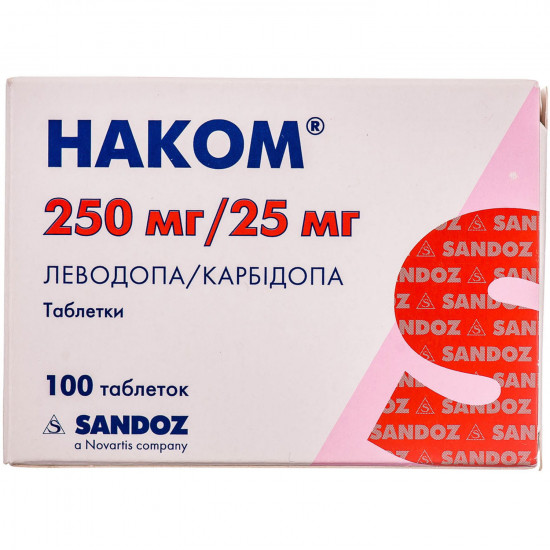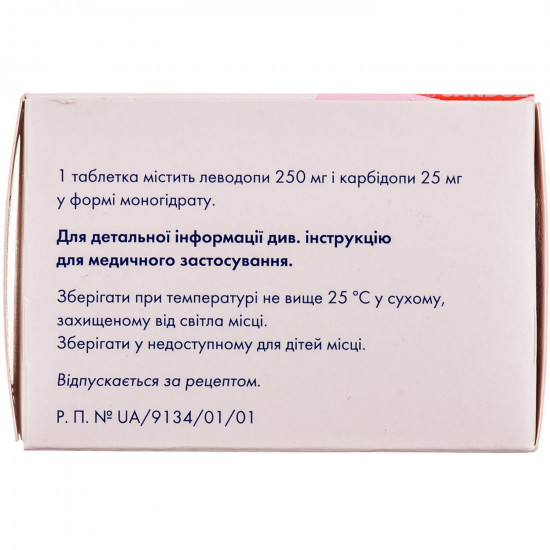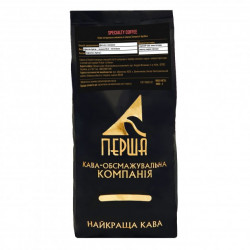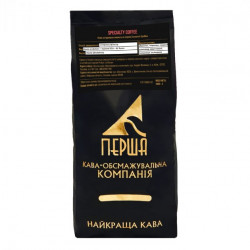



- Stock: In Stock
- Model: 184327
0% Customers recommend this product
-
5 Awesome0%
-
4 Great0%
-
3 Average0%
-
2 Bad0%
-
1 Poor0%
Reviews Over NAC of the tab. 25mg/250mg No. 100
- (0)
Total Reviews (0)
click here write review to add review for this product.
Report this review.
Description
Pharmacological properties
Pharmacodynamics. the NAC — the combined protivoparkinsonichesky drug, the containing metabolic predecessor of a dopamine — a levodopa and inhibitor of a peripheral dopa-decarboxylase — to a karbidop.
As is assumed, symptoms of Parkinson's disease are connected with insufficient quantity of a dopamine. Normal the dopamine performs function of a neurotransmitter and is made in the certain cells of a brain controlling muscular activity. Motive disorders consider a consequence of dopamine insufficiency.
Protivoparkinsonichesky action of a levodopa is caused by its transformation into a dopamine by decarboxylation directly in central nervous system that eliminates deficit of a dopamine in neurons.
Karbidop'swhich does not get through a blood-brain barrier interferes with ekstratserebralny decarboxylation of a levodopa thanks to what receipt of a levodopa in a brain and its transformations into a dopamine into central nervous system increases that leads to reduction of expressiveness of symptoms of Parkinson's disease at many patients.
Pharmacokinetics. The levodopa is quickly absorbed in a GIT and metabolized. Generally it turns into a dopamine, adrenaline and noradrenaline and finally into hydroxyalpha-toluic, gomovanilinovy and vanililmindalevy acids. In blood plasma and SMZh reveal to 3-O-Methyldopum. T ½ levodopas makes about 50 min. of blood plasma. At the combined use of a karbidopa and levodopa of T ½ levodopas raises up to 1.5 h. All metabolites of a karbidopa and a levodopa are removed with urine.
Indication
Disease and Parkinson's syndrome.
Use
Mode of dosing is set individually, depending on disease severity, the accompanying pathology and therapeutic effect for the adult patients who were earlier treated by drug. in need of a tablet it is possible to halve on a distributive strip. for achievement of optimum effect it is better to take the medicament daily, without taking a break in use.
Patients who were earlier not receiving a levodopa. For patients who begin administration of medicament by the NAC the initial dose makes ½ tablets 1 or 2 of time a day after a meal. But at the same time the necessary quantity of a karbidopa for many patients can not be provided therefore for achievement of optimum effect of treatment it is possible to raise a dose gradual addition on ½ tablets every day or every other day. The therapeutic effect is shown within 1 day, sometimes — after reception of one dose. The optimum effect is usually reached within 7 days in comparison with weeks or months at use only of a levodopa.
Patients accepting a levodopa. Reception of a levodopa should be stopped at least for 12 h (24 h for medicaments of a levodopa of slow release) prior to therapy by medicament by the NAC. The daily dose of medicament has to provide about 20% of the previous daily dose of a levodopa.
Initial dose. For patients who receive less than 1500 mg of a levodopa a day the initial daily dose has to be 75–100 mg of a karbidopa and 300–400 mg of a levodopa in 3–4 receptions (levodopas 1:4, that is with a dosage of 25 mg / 100 mg use medicament with a ratio karbidopy/).
For the patients accepting more than 1500 mg of a levodopa a day the initial dose of medicament the NAC has to make on 1 tablet 3–4 times a day.
Maintenance dose. Therapy using the combined medicament by the NAC has to consider specific features of patients, the dosage can gradually change depending on therapeutic effect.
In case the bigger quantity of a levodopa is necessary, a dose of medicament it is possible to raise on ½ or on 1 tablet every next day to the maximum daily dose — 200 mg of a karbidopa and 2 g of a levodopa (8 tablets in 3–4 receptions) for patients with the body weight of 70 kg.
When the translation of the patient from a levodopa on medicament by the NAC is combined bywith other inhibitors of a decarboxylase, their use should be stopped at least for 12 h prior to medicament use by the NAC.
medicament Combination with MAO-B inhibitors is capable to increase efficiency of medicament the NAC in controlled cases of an akineziya and/or dyskinesia.
For the patients accepting along with medicament the NAC other protivoparkinsonichesky medicaments the need for dose adjustment of these means can arise.
Patients of advanced age: medicament is used at patients of advanced age.
Contraindication
Hypersensitivity to active ingredient or any of medicament excipients. heavy psychoses. heavy liver and renal failure. heavy heart failure. heavy cardiac arrhythmia. acute stroke. states at which adrenergic means are contraindicated (for example a pheochromocytoma, a hyperthyroidism, Cushing's syndrome). the suspicious not diagnosed formations on skin (dermatosis) or a melanoma in the anamnesis. closed-angle glaucoma. simultaneous use of selection inhibitors of Mao like an and non-selective inhibitors of Mao (except for low doses of separate inhibitors mao-b); it is necessary to stop uses of non-selective inhibitors of Mao and selection inhibitors of Mao like a not less than for 2 weeks before prescribing of drug.
Side effects
Side effects arising at medicament treatment by the NAC are caused by the central neuropharmacological activity of a dopamine. these reactions usually disappear at a dose decline. the most frequent manifestations are dyskinesia, including choreoid, dystonic and other involuntary movements and nausea. the first signs which testify to need of a dose decline are twitching of muscles and a nictitating spasm.
Other serious side effects — mental changes, including paranoid thinking and psychoses, a depression with suicide trends or without them, dementia. Note cases of pathological passion, increase in a libido and hyper sexuality at patients, especially at use in high doses; these manifestations disappear at a dose decline or the termination of therapy.
Other side effects about which it was reported in connection with use of a levodopa or its combination from karbidopy are systematized byon the systems of bodies.
from central nervous system: bradykinetic episodes (phenomenon of "inclusion switching off"), an ataxy, an asthenia, a disorientation, numbness, a tremor of hands, twitching of muscles, a nictitating spasm, a lockjaw, euphoria, dizziness, drowsiness, including it is very rare — excessive day drowsiness and sudden episodes of backfilling, paresthesia, psychotic episodes, including nonsense, nightmares, hallucinations and paranoid thinking, reduced ability to thinking, a depression with development of suicide intentions or without them, dementia, excitement, fear, confusion of consciousness, insomnia, an incoordination, fatigue, weakness, a headache, respiratory depression, activation of a latent syndrome of Horner, a malignant antipsychotic syndrome, a syncope, anorexia. Symptoms of disorder of control over motives and compulsive behavior (overeating, an oniomania, passion for gamblings) are possible. Very seldom — spasms.
from a cardiovascular system: disturbance of a warm rhythm / heartbeat, orthostatic effects, including arterial hypotension, AG, stethalgia, phlebitis.
from respiratory organs: asthma, abnormal breath.
from a digestive tract: nausea, vomiting, diarrhea, a constipation, an abdominal pain, dark saliva, dyspepsia, dryness and bitter smack in a mouth, hypersalivation, a dysphagy, a bruxism, hiccups attacks, gastrointestinal bleeding, a meteorism, burning sensation of language, development of an ulcer of a duodenum.
Disorder of metabolism: increase or degrowth of a body, hypostases.
from skin and hypodermic fabrics: rushes of blood suit, the increased sweating, coloring of sweat in dark color, a hair loss, rash, an itching.
Allergic reactions: a Quincke's disease, a small tortoiseshell, Shenleyn's disease — Genokh.
from an urinary system: an urination delay, urine incontinence, coloring of urine in dark color, a priapism.
from blood: leukopenia, hemolytic and not hemolytic anemia, thrombocytopenia, agranulocytosis.
from an organ of sight: diplopia, mydriasis, oculomotor crisis, turbidity of sight.
Others: general weakness and indisposition, disturbance of gait, hoarseness of a voice, inflows, asthma, malignant melanoma.
Laboratory indicators: increase in indicators of function of a liver, such as SF, AlAT, AsAT, LDG, bilirubin, urea nitrogen in blood, creatinine, uric acid, positive test of Koombs.
decrease in hemoglobin and a hematocrit, increase in level of glucose in blood plasma Seldom noted, a leukocytosis, a bacteriuria, a hamaturia.
Special instructions
Drug should not be used for treatment of the extrapyramidal reactions which resulted from use of medicines.
should appoint Drug bywith care to patients with a serious illness of a cardiovascular system and lungs, OH, diseases of kidneys, a liver and an endocrine system, with a peptic ulcer or spasms in the anamnesis. With care appoint the NAC also to the patients who recently had a myocardial infarction in the presence of atrial, nodal or ventricular arrhythmia. At such patients it is necessary to watch a condition of a cardiovascular system, especially when determining an initial dose.
Should observe attentively patients in time to reveal at them development of a depression with accompanying suicide intentions. Patients with psychoses (including in the anamnesis) require special attention.
NAC, as well as other medicaments of a levodopa, can cause involuntary movements and mental disorders. It is supposed that such reactions are caused by increase in concentration of a dopamine in a brain after purpose of a levodopa. The dose decline can be required.
to Patients with a chronic open angle glaucoma should appoint bymedicament with care on condition of constant control of intraocular pressure and careful observation of its changes during treatment.
At sudden medicament withdrawal were noted by a complex of the symptoms similar to a malignant antipsychotic syndrome with manifestations of muscle tension, a hyperthermia, changes in mentality and increase in the KFK level in blood plasma. Careful observation of a condition of patients which reduce a dose of medicament is necessary or carry out its difference, especially if the patient at the same time applies neuroleptics.
during long-term treatment needs to control periodically a functional condition of a liver, kidneys, the cardiovascular system and the system of a hemopoiesis.
karbidopa Drugs with a levodopa can cause false positive reaction to ketone bodies in urine if for definition of a ketonuria use an indicator tape. This reaction does not change after boiling of tests of urine.
False-negative results can be received bywhen using a glyukozooksidazny method of testing of a glucosuria.
Epidemiological researches showed that in the presence of Parkinson's disease the patients have higher (approximately by 2–6 times) risk of developing a melanoma. Therefore at medicament use by the NAC the constant control behind the patient's skin is recommended.
Use during pregnancy or feeding by a breast. Influence of medicament on the course of pregnancy it is unknown, however both the levodopa and its combinations from karbidopy caused malformations of internals and a skeleton of a fruit in an experiment on animals. Therefore it is not necessary to use medicament during pregnancy.
In case of need uses of medicament during feeding by a breast, for treatment it is necessary to stop feeding by a breast.
Children. Safety and efficiency of medicament at children is not established therefore it is not recommended to appoint to patients aged up to 18 years.
Ability to influence speed of response at control of vehicles or work with other mechanisms. Considering that at use of medicament there can be side reactions (dizziness, hallucinations, uncontrollable movements, drowsiness, cases of a sudden dream, a visual disturbance), for the period of administration of medicament it is necessary to refrain from control of vehicles and performance of other works demanding concentration of attention.
Interaction
Antihypertensive drugs. patients who together with medicament the NAC apply antihypertensive medicaments can have an orthostatic hypotension. dose adjustment of antihypertensive medicament can be necessary.
Antidepressants. Separate messages about emergence of negative reactions, including AG and dyskinesia, the tricyclic antidepressants and medicament caused by simultaneous use the NAC were (for the patients accepting MAO inhibitors).
Iron. Decrease in bioavailability of active ingredients of medicament by the NAC at use with ferrous sulfate or a gluconate of iron is shown.
Anesthetics. Simultaneous use of anesthetics can cause arrhythmia.
Anticholinergics. Can work synergy together with a levodopa for decrease in a tremor, however they can strengthen uncontrollable movements. In high doses they can also reduce positive effect of a levodopa by delay of its absorption.
Other medicines. Antagonists of receptors of a dopamine of D 2 (for example fenotiazina, phenyl propyl ketones and risperidon) and an isoniazid can reduce therapeutic effect of a levodopa.
Positive effect of medicament the NAC in Parkinson's disease can be reversible at use of Phenytoinum and a papaverine.
Combined therapy with selegiliny can leadto the heavy orthostatic hypotension uncharacteristic for medicament the NAC.
As the levodopa competes with some amino acids, at the patients who are on a high-protein diet the absorption of a levodopa can be broken.
At simultaneous use with antacids influence on bioavailability of a levodopa was not studied.
Perhaps simultaneous use by the NAC and the means containing 6 vitamin B (a pyridoxine a hydrochloride).
Overdose
Symptoms: disturbance of a warm rhythm, involuntary movements, nictitating spasm.
symptomatic treatment. The pyridoxine ( 6 vitamin B ) is inefficient for prevention of effect of drug.
ECG monitoring and careful control of the patient regarding a possibility of development of arrhythmia Is necessary for. It is necessary to consider also that together with medicament the NAC the patient can apply other medicines. Experience of use of dialysis is absent.
Storage conditions
At a temperature not above 25 °C in the dry, protected from light place.
Specifications
| Characteristics | |
| Active ingredients | Karbidopa, Levodopa |
| Amount of active ingredient | 25 mg + 250 mg |
| Applicant | Sandoz |
| Code of automatic telephone exchange | N04BA02 the Levodopa with decarboxylase inhibitor |
| Interaction with food | It doesn't matter |
| Light sensitivity | Sensitive |
| Market status | The branded generic |
| Origin | Chemical |
| Prescription status | According to the prescription |
| Primary packing | blister |
| Producer | LEK PHARMACEUTICAL COMPANY OF D.D. |
| Quantity in packing | 100 tablets (10 blisters on 10 pieces) |
| Release form | tablets for internal use |
| Route of administration | Oral |
| Sign | Import |
| Storage temperature | from 5 °C to 25 °C |
| Trade name | NAC |




















